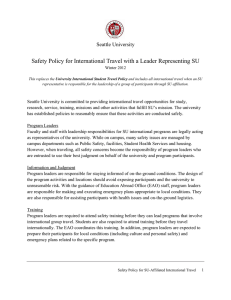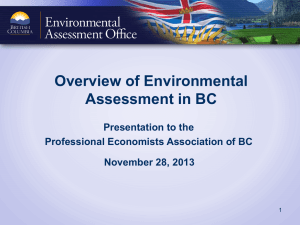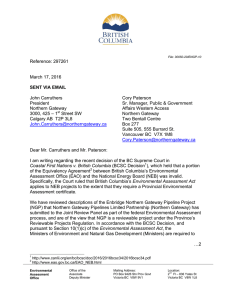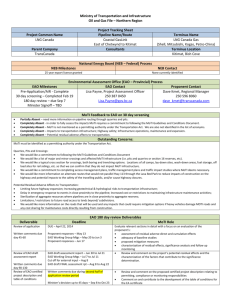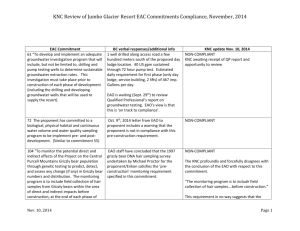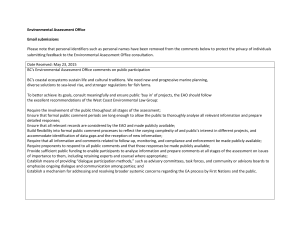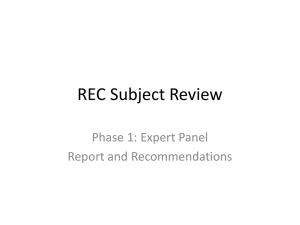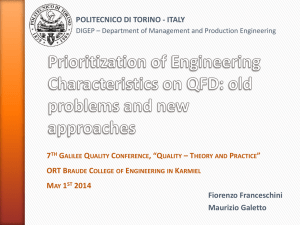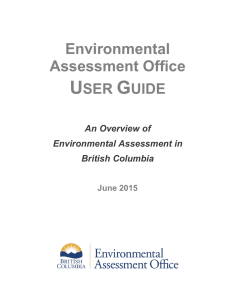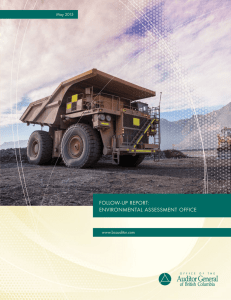November 26 2012 Notes BC EA Law
advertisement
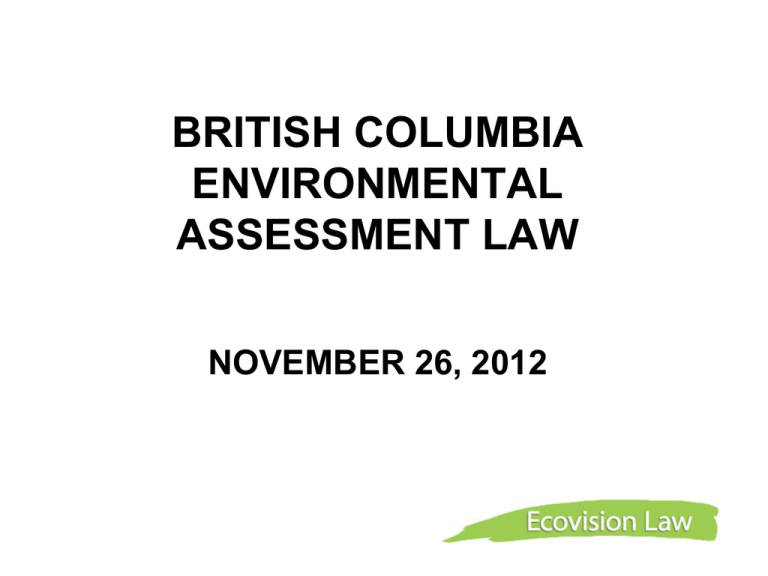
BRITISH COLUMBIA ENVIRONMENTAL ASSESSMENT LAW NOVEMBER 26, 2012 Overview • Environmental Assessment Act Elements • Environmental Assessment Act – Issues • BC Auditor General Report • Northwest Institute Report comparing Federal/Provincial EAs for Prosperity Mine Environmental Assessment Act • Environmental Assessment Act (EAA) passed in 1994, amended in 2002 • Environmental Assessment Office (EAO) established under EAA to provide “open, accountable and neutrally administered process” to assess “reviewable projects” • Reviewable Projects Regulation identified projects to be reviewed (energy, mining, industry) Purposes • “promote sustainability by protecting the environment and fostering a sound economy and social well-being” • “prevent or mitigate adverse effects of reviewable projects” • Repealed in 2002 amendments Key Elements • Projects reviewable by virtue of regulation, EAO executive director discretion, ministerial order • Reviewable projects not be constructed without provincial EA certificate • EAO reviewable project determination • EAO makes order on scope, procedures, methods for project EA • Proponent proposes terms of reference for EAO approval Key Elements • Proponent assembles required information and public input, applies for EA certificate • EAO reviews application and assessment report for two or more ministers with jurisdiction • Ministers decide to issue certificate, specify conditions, or refer for further assessment Key Elements (1994) • Mandatory project committees to advise ministers (provincial, federal, municipal, regional, First Nations representatives) • Public advisory committee to make recommendations to project committee • Mandatory public notice provisions at each of four EA process stages • Environmental Assessment Board to conduct hearings on projects referred by Ministers Key Amendments (2002) • Provided decision-making flexibillity for EAO and Ministers (“less regimented” “more timely and cost-efficient”) • Mandatory project committees replaced by working groups with reduced role • Public advisory committees eliminated • Public consultation mainly by proponent • Mandatory public notice provisions replaced by policy guidance Reviewable Project Regulations • Coal Mine – 100,000 t/yr (1994), 250,000 t/yr (2002) • Mineral Mine - 25,000 t/yr (1994), 75,000 to/yr (2002) • Energy Project - 20 MW (1994), 50 MW (2002) • Urban Transit Rail - 8 km (1994), 20 km (2002) Implications of Thresholds for Reviewable Project Regulations • Vancouver Airport Light Rail Project would not have been reviewed (less than 20km) • BC Energy Plan opened up hydro development to private sector – January 2009 – 145 water power licences plus 621 applications (many at 49MW); only 25 subject to BC EA process Key Issues • • • • Project Thresholds Links to land use planning, strategic EA Adequacy of public participation Suitability of EA to meet Crown consultation responsibilities • Rigour of Process Prosperity Gold/Copper Mine Prosperity Mine Prosperity Mine • Proponent Taseko re-activated BC EA process in 2002, federal process in 2006 • RAs: DFO, Transport Canada, NRCan • DFO referred project to Environment Minister for panel review in February 2007 • BC decided to proceed with provincial review in June 2008 not joint panel review • Environment Minister referred to federal review panel in January 2009 Prosperity Mine • EA processes conducted separately with province approving project before federal panel review completed • BC approved mine; feds rejected mine on recommendation of federal panel • Why different findings and conclusions? Comparison of BC and Federal EA Processes • Analysis by Northwest Institute July 2011 • BC EAO “only one significant adverse effect” “limited to a discrete location” loss of fish and fish habitat at Fish Lake/Little Fish Lake • BC ministers advised adverse effects justified by “very significant employment and economic benefits” and proponent’s fish habitat compensation program Comparison of BC and Federal EA Processes • Federal panel found eight additional significant eight adverse effects: grizzly bears, navigation ,local tourism, grazing, First Nation’s trapline, First Nations’ traditional land use and cultural heritage, Aboriginal rights, future generations. • Proponent’s fish habitat compensation program not viable, mitigation not sufficient Comparison of BC and Federal EA Processes • Why divergent outcomes? • Process: BC “review and comment” process vs. federal panel hearings • Information: Federal panel had more complete information (DFO, First Nations) • Expertise: Federal panel members highly qualified (chair with 27 years experience); EAO four staff on working group Comparison of BC and Federal EA Processes • Participant Funding – feds yes; BC no • Significance Determination - EAO used large geographic area as baseline; feds, CEA Agency guidelines • Mitigation: BC lacked clear mitigation and compensation policies, deferred to future planning efforts; feds “no net loss” fish habitat policy Comparison of BC and Federal EA Processes • Standards and Criteria: BC lacks standards/criteria to guide decisionmaking comparable to Fisheries Act/SARA • Legislation: BC Environmental Assessment largely procedural, lacked many substantive aspects of CEAA • Independence: Federal Panel independent unlike EAO Working Group Comparison of BC and Federal EA Processes • Federal panel found eight additional significant eight adverse effects: grizzly bears, navigation,local tourism, grazing, First Nation’s trapline, First Nations’ traditional land use and cultural heritage, Aboriginal rights, and future generations. • Proponent’s fish habitat compensation program not viable, mitigation not adequateWhat accounts for such divergent outcomes? This report reviews Report of BC Auditor General on BC EAO July 2011 • Focused on post-certification • EAO’s oversight of certified projects not sufficient to ensure that potential significant effects are avoided/mitigated • EAO not ensuring that: – certificate commitments are measureable, enforceable – monitoring responsibilities are clearly defined – compliance and enforcement actions are effective Report of BC Auditor General on BC EAO • EAO not evaluating effectiveness of environmental assessment mitigation measures to ensure projects are achieving desired outcomes • EAO not making appropriate monitoring, compliance and outcome information available to public to ensure accountability
